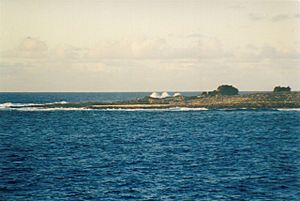List of National Monuments of Chile facts for kids
The National Monuments of Chile (Spanish: Monumentos Nacionales de Chile), also abbreviated MN, are the legally protected constructions, elements and places that form part of the country's cultural heritage. They are national heritage sites that are an important part of the culture of Chile.
Contents
Definition and categories
Law N° 17.288 concerning national monuments stipulates that:
National monuments are places, ruins, constructions or objects of historical or artistic character; burial sites or cemeteries or other remains of aborigines, anthropo-archaeological, paleontological or natural formation pieces or objects, which exist under or on the surface of the national territory or underwater within its jurisdictional waters and whose conservation is of interest to history, art or science, and are under the custody and protection of the State; sanctuaries of nature; monuments, statues, columns, pyramids, fountains, plaques, inscriptions and, in general, objects that are destined to remain in a public place, with a commemorative character.
As of October 2008[update] there are 938 national monuments. They are grouped into the following categories:
-
- Historic monuments (633).
- Public monuments (150).
- Archaeological monuments (21).
- Typical or picturesque zones (95).
- Nature sanctuaries (39).
Historic monuments
Historic monuments are defined as:
...those places, ruins, constructions and objects of fiscal, municipal or private property that, due to their quality and historical or artistic interest or due to their antiquity, are declared as such by supreme decree, issued at the request and prior agreement of the Council.
In the register of the National Monuments Council, there are 633 historic monuments as of October 2008[update]. These include:
-
- Aduana de Antofagasta
- Agustín Ross Cultural Centre
- Clipper Ambassador
- Biblioteca de Santiago
- Capilla San Juan de Dios, Chillán
- Casa Lo Contador
- Cerro Santa Lucía
- Chacabuco
- Chapel of former Lazareto de San Vicente de Paul
- Chivilingo Hydroelectric Plant
- Constitucion Talca Ramal
- Cousiño Palace
- Escuela de Artes y Oficios
- Estación Central
- Estación Mapocho
- Estadio Nacional de Chile
- Funicular railways of Valparaíso
- Humberstone and Santa Laura Saltpeter Works
- Iglesia de Nuestra Señora de las Mercedes
- Iglesia San Francisco del Monte
- Iglesias de Chiloé
- La Moneda Palace
- Larmahue water wheels
- Londres 38
- Melbourne Clark company wharf
- Monastery of the Holy Trinity (Las Condes)
- Morro de Arica
- National Library of Chile
- Palace of Cerro Castillo
- Palaces in Santiago
- Ruins of Huanchaca
- St. Paul's Cathedral (Valparaíso)
- Santiago Stock Exchange
- Trolleybus system of Valparaíso
- Valdivieso advertising sign
- Villa Grimaldi
- Votive Temple of Maipú
- Wulff Castle
Public monuments
Public Monuments are all commemerative objects in public places.
The National Monuments Council is trying to create a register in which all public monuments can be listed, using information from the local authorities. As of October 2008[update], there are 150 public monuments on the list. These include
-
- Hito al Trópico de Capricornio
Archaeological monuments
Archaeologic monuments are defined as:
places, ruins, deposits and anthropo-archaeologic pieces that exist under or on the national territory surface.
As of October 2008[update], the register of the National Monuments Council lists 21 archaeological monuments. These include:
Typical or picturesque zones
Urban or rural properties that form a unity and are notable by their style, materiality or constructiontechnique are designated as typical or picturesque zones:
With the purpose to hold the environmental nature proper of some towns or places where could exist archaeologic ruins, or ruins and buildings declared Historic Monuments, the National Monuments Council can request to be declared of public interest the protection and preservation of these towns or places, or some zones of them.
In the register of the National Monuments Council, as of October 2008[update], there are 95 typical zones. These include:
-
- Andacollo
- Angelmó
- Barrio Concha y Toro
- Barrio París-Londres
- Cajón del Maipo
- Historic centre of Chanco
- Elqui River Valley
- Humberstone
- Historic centre of Iquique
- Historic centre of Los Andes
- Market building, Chillán
- Paseo Atkinson
- Pichilemu
- Plaza de Armas, Former National Congress of Chile building, and nearby buildings, Santiago
- Plazuela Marcelino Champagnat
- Recova de la Serena
- Ruta del Vino
- Sewell, Chile
- Túnel del Cristo Redentor
- Viaducto del Malleco
Nature sanctuaries
Nature sanctuaries are defined as:
Are sanctuaries of nature all of the terrestrial or marine sites that could offer special possibilities for studies and geologic, paleontologic, zoologic, botanic or ecologic investigations, or that have natural formations, which conservation could be of interest for the science or for the State.
39 nature sanctuaries have been designated.
See also
 In Spanish: Monumentos nacionales de Chile para niños
In Spanish: Monumentos nacionales de Chile para niños
- List of National Monuments of Chile by region



